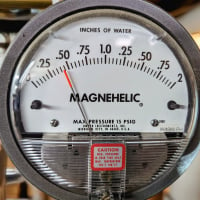A/C Capacitor Voltage
Hello…. My A/C fan unit Capacitor went bad.. Went to the ye ol' A/C supply store, brought the old one with me for the guy to compare… The only difference is the voltage.. My old one has 440/370VAC..
The new one has just 370VAC… Will that make a difference on how the A/C will run?
Thanks!
Comments
-
No,
The 440/370V cap is actually just a 440V cap.
I assume your system is running on 240-250VAC in a residential installation? If so, the 370v cap is fine, but I prefer the higher voltage ones as they should last longer.
I assume the "uf" rating on the new cap is identical to the old one? That's important. Something like, 5uf?
Single pipe 392sqft system with an EG-40 rated for 325sqft and it's silent and balanced at all times.
0 -
If you need a 370 V capacitor you can use a 440 v capacitor. If you need a 440 V capacitor you can not use a 370 V capacitor. So if you don't know if you need a 370 or 440 then you should use the 440. If you can find the original specification in the equipment docs, and it specifies a 370, the you are good to go.
Edward Young Retired
After you make that expensive repair and you still have the same problem, What will you check next?
2 -
TL;DR: it's probably fine. If in doubt, get the higher rating.
Compressor, fan, dual? If you went to the supply house & they looked it up from the unit model & serial, I would imagine that's the right one. If you just crossed it over from the existing, I would've expected a 440 volt one, or dual rated. Like @ChrisJ and @EdTheHeaterMan said, a higher voltage rating will substitute for a lower—but not vice versa.
It's my understanding that the motor design determines the voltage of the cap. (I read that on the Internetz some time in the last few decades, so it must be true!) In any case, you can verify the voltage by simply measuring the voltage across the cap with the unit operating, it'll be around 370 volts, or it'll be around 440 volts. The outdoor fan motor and the compressor both should have a nameplate that specifies the capacitance and voltage of the required cap. Two separate ones work the same as a dual. Oval vs round is merely mechanical, you can use either if you can get it tucked up in there somewhere.
1 -
I tried to verify what determines the voltage of the cap and didn't come up with anything I'd call conclusive from the internet. Some say back EMF, others say peak line voltage.
120vac peak is 175, so 350 peak on a 240-250v circuit, and that would explain the 370 but I can't imagine wat the 440v cap is for then. That's what, 311rms? So maybe it is 100% based on back EMF.
I don't know.
Single pipe 392sqft system with an EG-40 rated for 325sqft and it's silent and balanced at all times.
0 -
IDK either, but the ol' memory banks keep coming up with the same thing I said earlier. I think it was a motor manufacturer's website so I put a little more confidence in it than if it was from some rando blog. I did measure one once & found 37something. Slightly over the actual rated voltage, but I know from experience that they are reasonably reliable.
1 -
The voltage rating refers to what voltage the capacitor is rated to withstand, not to what voltage that will be measured at its terminals. If the actual measured voltage is in excess of its RATED voltage, then a higher rated capacitor should be used.
It never hurts to go up in rated voltage. In fact, it’s a good practice.
Bob Boan
You can choose to do what you want, but you cannot choose the consequences.1 -
When it comes to Capacitors for HVAC repair I stopped stocking 20 different dual and 15 different single caps in favor of the Turbo 200. Three of those per truck and one of the larger Turbo caps greatly reduced truck inventory costs and space. I can also offer a 3 year warranty on them because Turbo offers a 5 year warranty. I just need to cover the labor portion. That Turbos are all rated at 440 and you can build the exact uf you need. I know that they are more expensive that the ones made of chinesuim but the warranty suggests that they will last longer. A better deal for the customer that is paying retail for repairs.
Edward Young Retired
After you make that expensive repair and you still have the same problem, What will you check next?
2 -
-
-
-
-
I was under the impression that "WV" was different than "V" on capacitor ratings. As in voltage was absolute peak and should be avoided, but Working Voltage you could actually run it at safely.
I have some really good "computer grade" Mallory caps that have WVDC stated on the side. Unless that's just the manufacturer's choice in wording, but it didn't seem like it. I bought those caps new in 2008.
Single pipe 392sqft system with an EG-40 rated for 325sqft and it's silent and balanced at all times.
0 -
Most caps are rated wvdc. Motor caps are rated v ac. I assume that is to deal with the peak vs rms in ac voltages and that people dealing with motors are bad at math. Motor caps are special in a number of other ways too because they are carrying significant current and I think they are also bipolar. Run caps have to carry a continuous current, start caps just have to carry that current briefly.
0 -
This is exactly correct. You can go up in voltage rating as long as you match the uF rating. Also some capacitors are designed as 'start' capacitors and others as 'run' capacitors. 'Start' capacitors are designed for a few seconds of operation at a time, and will overheat if used continuously as a run capacitor. Run capacitors are designed for continuous use, and can be used as start capacitors, but will probably be un-necessarily physically larger and more expensive).
As a rule of thumb, if this is a 120V motor you will need a 370V rated capacitor (a lower rating would probably work, but they are not commonly made, so you end up with 370V); if this is a 240V motor you will need a 440V rated capacitor. The voltage applied to the capacitor is significantly higher than the supply voltage going to the motor. (See https://youtu.be/rUqL9MqwimA for someone actually measuring the voltage applied to the capacitors when the motor is running).
In general a higher voltage rating is good because the capacitor will last longer.
The 370/440V rating is just the manufacturer's way of making it clear that you can use a 440V capacitor in place of a 370V capacitor.
1 -
I was just wondering if everyone knows what uF stands for?
That symbol is not actually the letter "u" but the greek letter µ pronounced Mu like you might here a snobby cat from the upper east side say MEOW. The µF stands for Micro Farad and is sometimes labeled MFD or mfd. So… µF, uF, uf, mfd and MFD all mean the same thing depending on the letters available on your typewriter. But never say "you eff" for Micro-Farad because that is totally wrong. Always read uF as Micro Farad
That is the concludes todays Greek Lesson.
Edward Young Retired
After you make that expensive repair and you still have the same problem, What will you check next?
2 -
microfarad. was abbreviated mf or mfd before computer typesetting. 10^-6 and picofarad is 10^-12
0 -
Just to recap (sorry). You can safely use a capacitor with a higher VOLTAGE rating than required. No problem. You can NOT use a capacitor with a capacitance much more than 10 percent higher or lower than required.
Br. Jamie, osb
Building superintendent/caretaker, 7200 sq. ft. historic house museum with dependencies in New England4 -
The tolerance on that type of cap is usually 20% or more so 10% is probably a good rule of thumb because of the tolerance and substitution adding in some cases but you could probably get away with more. Usually the capacitance falls dramatically with lower temps.
0 -
The OP said his old cap was rated 370/440.
Not sure I have ever seen a cap with a dual voltage rating.
0 -
As others have said, it is just a 440 vac cap for those that don't understand capacitors.
0 -
-
Have you ever seen a capacitor rated at 250 VAC?
Look inside a Taco 007 circulator
and you will find one
Edward Young Retired
After you make that expensive repair and you still have the same problem, What will you check next?
0 -
-
yes I have seen caps rated 250 volt in 120volt window ACs
0 -
ok, now that I am totally confused, not really, I just want to make sure I got this right..
I had 440/370VAC, the new one is 370VAC… So, I really need a 440 Capacitor, correct? All the other specs are the same..
Thanks Again,
Scott
0 -
unless the motor ratings plate has a spec for the cap on it that says it can use a 370 vac cap.
0 -
Try to look and see what the motor says on it. If the label is still legible it'll tell you what it needs.
Or buy a 440v cap online and swap it out and you'll know it'll last. Make sure the "uf" spec is identical.
Single pipe 392sqft system with an EG-40 rated for 325sqft and it's silent and balanced at all times.
0 -
That 440/370V cap you described is actually just a 440V unit being labelled both ways for clarity. In most residential setups running on 240–250VAC, a 370V capacitor works just fine—but the 440V spec gives you a little more durability over time
The key here is matching the microfarad (µF) rating exactly—if that lines up, you’re golden. If you're ever unsure which to use, opt for the higher voltage—it's a simple tweak that keeps things running smoother and longer.
0 -
There is only one downside to choosing a higher voltage rating (within reason!): it may be physically larger. There are a lot of upsides. One of the more important is that a capacitor with a higher voltage rating is more durable — both in terms of resistance to the odd voltage spike but also in sheer longevity. Now as you get into really high voltage ratings — upwards of several thousand volts — cost begins to rise as well.
In same electronics applications, the type of capacitor may matter as well, but not in motor starting or the like.
Br. Jamie, osb
Building superintendent/caretaker, 7200 sq. ft. historic house museum with dependencies in New England0 -
If you have the model number of the unit you can look up the parts diagram and see what capacitor the unit originally came with. From there you can usually find the specs for the capacitor.
0
Categories
- All Categories
- 87.4K THE MAIN WALL
- 3.2K A-C, Heat Pumps & Refrigeration
- 61 Biomass
- 429 Carbon Monoxide Awareness
- 120 Chimneys & Flues
- 2.1K Domestic Hot Water
- 5.8K Gas Heating
- 115 Geothermal
- 167 Indoor-Air Quality
- 3.7K Oil Heating
- 77 Pipe Deterioration
- 1K Plumbing
- 6.5K Radiant Heating
- 395 Solar
- 15.7K Strictly Steam
- 3.4K Thermostats and Controls
- 56 Water Quality
- 51 Industry Classes
- 50 Job Opportunities
- 18 Recall Announcements





